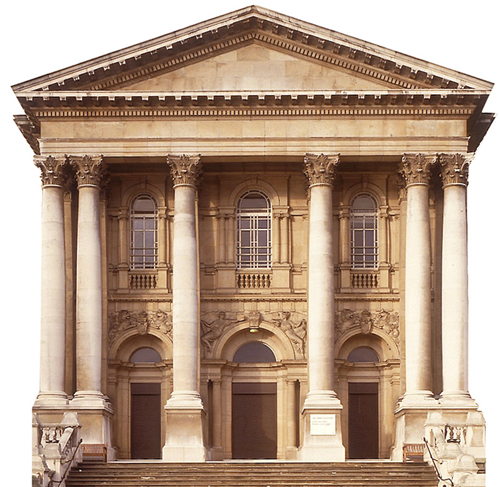Opened in 1897 as the national gallery of British
art, the magnificent collection at London’s first Tate gallery ranges
from 1500 to the present day. Its founder was Henry Tate (1819–99) who
made his fortune from sugar. The collection contains works by all
Britain’s major painters, and was greatly added to by J M W Turner.
Paintings are often moved to Tate’s other galleries, loaned out or
removed for restoration. The works on these pages, therefore, may not
always be on display.
Millbank SW1 020 7887 8888
www.tate.org.uk
Open 10am–5:50pm daily. Late opening first Fri of the month until 9pm. Closed 24–26 Dec Free (admission charge for most temporary exhibitions) Tate-to-Tate boat service travels between Tate Britain and Tate Modern every 20 minutes from Millbank Pier outside Tate Britain
|
|
The permanent collection
occupies three-quarters of the main floor. Starting in the northwest
corner, it follows a broad chronological sweep from the 16th century to
the present. The collection is arranged into rooms exploring historical
themes interspersed with displays devoted to single major artists.
Impressive loan exhibitions covering all manner of British art are
installed in the remaining quarter of the main floor and in the six new
galleries on the lower floor. The Turner Bequest, some 300 oil paintings
and about 20,000 watercolours by J M W Turner, is displayed in the
adjoining Clore Gallery, with oil paintings and watercolours on view.
|

Tate Britain’s grand portico
|
Excellent restaurant, with good wine list.
|
|
|
Free guided tours, talks and films every day of the week. Free audio guides are also available.
|
|
|
Comprehensive art bookshop.
|
|
Top 10 PaintingsNorham Castle, Sunrise J
M W Turner (1775–1851) was the great genius of English landscape
painting. This work typifies his use of abstraction and luminosity of
colour. The Deluge Irish
artist Francis Danby (1793–1861) moved to London from Bristol in 1824,
where he painted large-scale biblical subjects as well as fantasy
landscapes, such as this work. Wooded Landscape with a Peasant Resting Thomas
Gainsborough (1727–88) was a portrait and landscape painter and a
favourite of the Royal Family. His family groups in landscapes are among
the finest “Conversation pieces” in English art. An artistic
interpretation of his native Suffolk, this is one of his earliest
landscapes, painted in 1747. Three Ladies Adorning a Term of Hymen Joshua
Reynolds (1723–92) was the first president of the Royal Academy and a
painter in the “Grand Manner” – as typified by this painting. He raised
the international status of British art. The Lady of Shalott Educated
at the Royal Academy Schools in London, John William Waterhouse
(1849–1917) famously revived the literary themes of the Pre-Raphaelites,
as seen in this piece. Waterhouse’s subject is taken from Lord Alfred
Tennyson’s tragic poem of the same name. Elohim Creating Adam Born
in London and trained at the Royal Academy School, poet, mystic,
illustrator and engraver William Blake (1757–1827) claimed to be guided
by visions. Elohim Creating Adam is typical of his work, of which the Tate has a large collection. Girl with White Dog This
picture by Lucian Freud (b1922) shows the artist’s wife while pregnant.
The style of the painting has roots in the linear portraiture of the
19th-century French painter Ingres. Carnation, Lily, Lily, Rose John
Singer Sargent (1856–1925) moved to Britain from Paris in 1885 and
adopted some of the Impressionist techniques established by his friend,
Claude Monet. The title of this work is from a popular song of the time. Recumbent Figures One
of several 20th-century artists from Yorkshire, Henry Moore (1898–1986)
was an outstanding sculptor whose work is on public display around
London. This drawing by Moore shows two sleeping figures. Three Studies for Figures at the Base of a Crucifixion Leading
light of the Soho arts scene, Francis Bacon (1910–1992) was
uncompromising in his view of life. When first shown, this series of
paintings caused an immediate sensation, shocking audiences with their
savage imagery. They have become some of his best-known works.
|